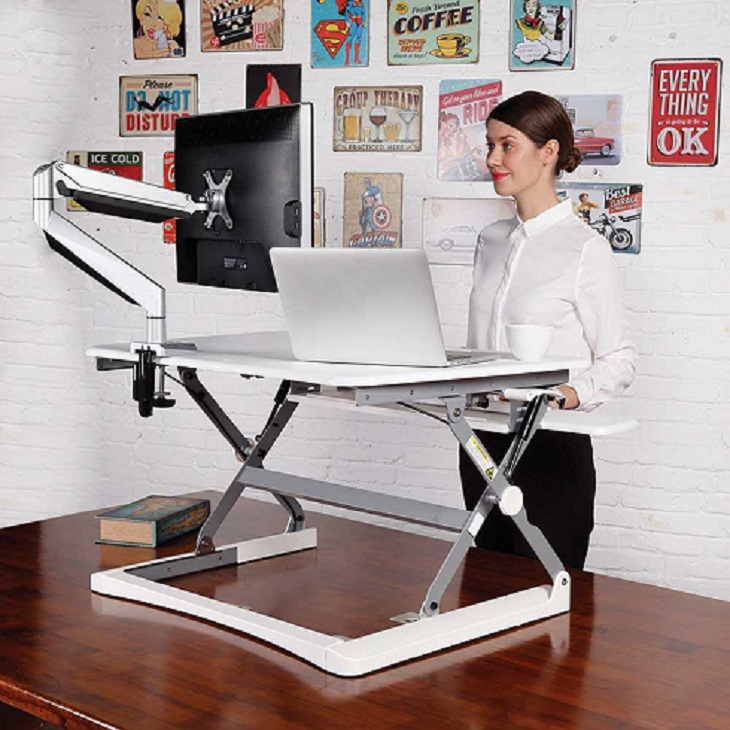Sitting down all day is bad for your health; that’s old news by now. Those of us who spend most of our workday seated at a desk are at greater risk of increased blood pressure, abnormal cholesterol levels, cardiovascular disease, and even certain types of cancer.
While technological advances have undoubtedly created immeasurable benefits and economic value, the impact hasn’t been quite as positive for our health and wellbeing.
None of us want to be unhealthy. Other than feeling awful, being in pain or unwell impacts our personal and work life, making us far less productive than we could be.
Could ergonomics be the solution to this?
Workplace ergonomics
With the advancement of technology and mobile devices, ergonomics in the workplace is more important than ever.
While enabling more flexibility in terms of where and when we work, technology was not designed with the human body in mind. It has inadvertently extended the work week and replaced physical activity which is a natural part of our lives.
“Our bodies have evolved over millions of years to do one thing: move. As human beings, we evolved to stand upright. For thousands of generations, our environment demanded nearly constant physical activity” says Dr. James Levine Ph.D., an international government consultant.
Dr. Levine has published extensive research about the detrimental effect sitting (which he describes as the new smoking) is having on civilised societies. His research is compelling and strengthens the case for making ergonomic resources and design in the workplace a priority.
We sit during our morning commute, at our desk, in meetings, and at lunch. We drive home, we sit at the dinner table or restaurant, and then we sit and watch TV. We can shop, pay bills, work, be entertained, and even socialise whilst sitting idly for extended periods.
Ergonomics is increasingly important in the design and furnishing of workspaces. As an example, the Danish government has mandated that all office workers must have a height adjustable desk.
It’s crucial for job efficiency and productivity, so addressing it right away with new recruits is a great way to stop bad habits from forming. Remember that younger staff have grown up with technology and so have likely already developed some bad habits, potentially causing musculoskeletal injuries that the older among us didn’t experience until after many years on the job.
With all of this in mind it’s clear that ergonomics should be a fundamental part of your business plan, and at the forefront of everyone’s mind.
Incorporating ergonomics
The goal of ergonomics is to establish a comfortable posture and adapt your work habits to maintain a healthy body and mind. Interrupt your sedentary stints as often as possible. “Stand up every half hour,” says Neville Owen, Ph.D., an expert in human movement and health.
Of course, ergonomics extends far beyond height-adjustable desks. Poor ergonomic designs can cause musculoskeletal disorders, one of the most common being carpal tunnel syndrome. Other complaints include stiff necks, sore backs, headaches and migraines, and even ganglion cysts from repetitive movements.
You can reduce your risk of injury, fatigue, and disease by switching your workstation furniture and computer accessories for ergonomic alternatives and incorporating more physical activity into your work day.
Ergonomics is not a one-size-fits-all solution and best practice highlights the importance of staff trying out a variety of devices and furniture options. Not everybody is the same, and a thorough testing and experimental process can highlight what is most important for each individual.
By focusing on the ergonomic benefits of your office products, you are protecting the most important assets you have – your health and wellbeing.
10 Tips for a good ergonomic workstation:
- Inject more movement into your day and alleviate back strain by using a sit-stand desk, which is the ultimate ergonomic desk.
- Stand up to take phone calls and go for walks with colleagues to brainstorm.
- Switch between your ergonomic chair and a large stability ball, which will force you to engage your muscles.
- Sit upright! It might sound obvious, but are you doing it? Slouching puts pressure on the discs and vertebrae of your back.
- Be aware of your head position and try to keep the weight of your head directly above the neck. Don’t “crane” your head and neck forward.
- To further minimise neck strain the monitor/laptop should be placed at eye level and directly in front of you. Adjust your chair or use a monitor riser to keep the screen at the ideal height.
- To avoid eye strain, your monitor should ideally sit at least an arm’s length away from you.
- Support the weight of your arms and wrists with an arm or wrist rest. If not, the muscles of your neck and shoulders will be tense by the end of the day.
- If possible, use a headset or a device that doesn’t require you to hold your phone up to your ear for long periods of time.
- If you’re a shorty whose feet don’t comfortably reach the floor, use a footrest or lower your chair.
No products were found with the applied settings

